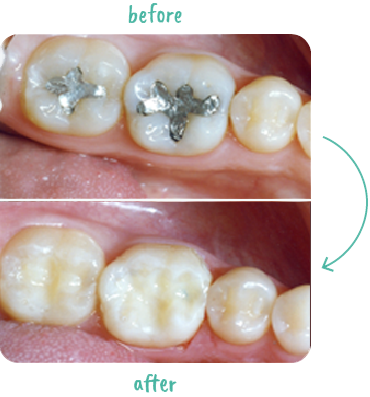Dental Fillings

Have questions about dental fillings? Our dentists took some time to share information and answer common patient questions to help educate about how dental fillings work and what they are made of. View the table of contents below to learn more or find your question and get an answer from one of our dentists!

The following content was provided by Dr. Garrett Solecki, General Dentist, and has been medically reviewed for accuracy. Some relevant links have been added to audio transcripts to provide resources for additional information.
Table of Contents:
Click on a question below to be taken directly to that answer.
- What is a dental filling?
- How long do dental fillings last?
- What are dental filings made of?
- Does it hurt to get a filling?
- Can I get a filling on a crowned tooth?
- Can I update my metal filling to a tooth colored filling?
- Can sugary drinks hurt dental fillings?
- How do dental fillings attach to your teeth?
- Pros and Cons of updating a metal filling to a tooth colored filling
- Why do metal dental fillings still exist?
- Will my dentist tell me if I need a filling replaced during my dental exam?
What is a dental filling?
Answer provided by Dr. Garrett Solecki. Transcript included below.
Dr. Solecki:
So a dental filling is a restorative, dental material that we use to replace missing tooth structure from either a cavity removal or if you have a chipped tooth. These materials, they’re usually inert and biocompatible, and the main ones that patients might be familiar with are the composite, the tooth colored ones, or the silver, amalgam fillings.
How long do dental fillings last?
Answer provided by Dr. Garrett Solecki. Transcript included below.
Dr. Solecki:
That is also a tricky question. It depends on a lot of factors like how big the filling is, where in the mouth the filling is, what surfaces of the teeth the filling is, and what the filling is made of. Fillings should typically last at least five years, but I’ve seen patients have fillings in their mouth 20, 30 years old.
What are dental fillings made of?
Answer provided by Dr. Garrett Solecki. Transcript included below.
Dr. Solecki:
So there’s two types of fillings we use today. The classic one is the amalgam filling, which comprises of silver, tin, copper, zinc, and mercury. Now the mercury that’s in those fillings is an inert mercury, it’s not the harmful one. And those are good, they’re very strong, they last a long time. The downside is patients don’t like the aesthetics because they’re silver. A lot of people don’t like to have a lot of metal in their mouth these days. So typically we do the tooth colored fillings, which we call them composite fillings. And they’re made of a resin, a silica, and some antimicrobial nanoparticles like fluoride that we talked about earlier.
Does it hurt to get a filling?
Answer provided by Dr. Garrett Solecki. Transcript included below.
Dr. Solecki:
So the filling itself does not hurt. We use local anesthesia. Depending on which tooth we’re working on, depends on what type of injection we’ll do. And patients are often worried about the needles as well, when we get them numb. Which we now use a topical anesthetic to get the gums numb before we even pick up a needle.
Can I get a filling on a crowned tooth?
Answer provided by Dr. Garrett Solecki. Transcript included below.
Dr. Solecki:
So short answer is yes, but if you need a filling on an already crowned tooth, there’s usually a bigger underlying issue at hand. It’s usually better, wiser and better for the long-term health of that tooth to replace that crown with another crown. A reason you might need to get another filling or replace your crown is if you have decay starting to come back underneath your old crown, which the best way is to replace the crown.
Can I update my metal filling to a tooth colored filling?
Answer provided by Dr. Garrett Solecki. Transcript included below.
Dr. Solecki:
We get a lot of patients that come in and ask that same question. There’s nothing wrong with the old fillings. A lot of people are worried about the mercury, which in the state it’s in and the filling is not harmful to the patients, and there’s always a risk in taking out an old filling and putting a new filling in. So I don’t recommend it unless that old filling is breaking down or if there’s decay underneath it. Otherwise, I usually recommend the patient leave them alone. If it’s on a front tooth and it really bothers them aesthetically, then I always go over the pros and cons of replacing it. But if you absolutely want to, you can, but it might not always be the best idea.
Can sugary drinks hurt my dental fillings?
Answer provided by Dr. Garrett Solecki. Transcript included below.
Dr. Solecki:
If you drink a lot of sugary drinks and you start to get a lot of erosion on your teeth, your teeth will start to change. They’ll start to wear away, but the fillings might not necessarily do the same. So they’ll start to stick out more. Your teeth might start to stain, but your fillings won’t stain, so they’ll be a lot more noticeable and a lot harder to keep clean.
How do dental fillings attach to your teeth?
Answer provided by Dr. Garrett Solecki. Transcript included below.
Dr. Solecki:
The amalgam ones are by mechanical retention. You have to create a lot of undercuts and it stays in there by the shape of how you’ve prepared that tooth. The tooth-colored ones actually chemically bond to the tooth, so after we take out the decay, we etch that tooth to increase the surface area and we put some binding agent on there to increase that bond strength, and then that chemically attaches to that tooth.
Pros vs. Cons of updating a metal filling to a tooth colored filling
Answer provided by Dr. Garrett Solecki. Transcript included below.
Dr. Solecki:
Obviously the first one would be aesthetics. It looks nicer. The shade matches your teeth. The cons would be weakening that tooth. Anytime we put a filling in a tooth, it will weaken that tooth, and if I take out an old filling and put in a new one, I have to remove a little tooth structure along with that old filling, so I’d be putting in a larger filling than the old one, which can weaken that tooth in that future as well.
Why do metal dental fillings still exist?
Answer provided by Dr. Garrett Solecki. Transcript included below.
Dr. Solecki:
So there are some times when metal fillings will actually be a benefit to the dentist and the patient. Whenever we place a filling, we have to make sure the mouth is really dry, the tooth is really dry, otherwise the tooth colored fillings won’t bond to the teeth. Sometimes if it’s impossible, if the patient has a lot of saliva, if we’re really far back in the mouth and we can’t keep it dry, you can still place those older metal fillings and they’ll still stay in place. When the resin fillings first came out, they weren’t as strong as the old metal fillings. But now with the new technology that’s come out, they’re just as strong, if not stronger. So there’s really no need to place the metal ones unless the patient really wants one.
Will my dentist tell me if I need a dental filling replaced during my dental exam?
Answer provided by Dr. Garrett Solecki. Transcript included below.
Dr. Solecki:
Sure. Every time you come in, every six months for your cleanings, the dentist will come in and do a quick exam. They’ll take a look at your X-rays if you took new ones. And on the X-rays, we can take a look, see if they’re starting to break down, see if there’s any decay underneath the older ones, and we can see how they look clinically as well.

